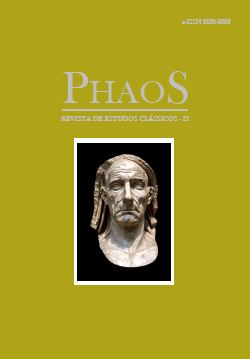Abstract
The main purpose of this paper is to discuss the construction and functions of similes in early Greek melic poetry. To this end, it approaches some formal aspects of the simile and focuses on three fragments, Sappho’s 96 (Voigt), Stesichorus’ 19 (Davies & Finglass), Ibycus’s S151 (Davies), and Bacchylides’ Epinician 5. In its argument, it takes into account the difficulties presented by the fragmentary condition of the songs and by the many possibilities of their performance, and the particularities of the compositions, which may not only reflect the traditional poetic language of the period, present as well in early Greek hexameter poetry but also reframe traditional images and myths.
References
AUBRIOT, D. “L’homme-végétal: Métamorphose, Symbole, Métaphore”. In: DELRUELLE, É.; PIRENNE-DELFORGE, V. (Eds.). Κῆποι. De la Religion à la Philosophie. Mélanges Offerts à André Motte. Liège : Centre International d’Étude de la Religion Grecque Antique, 2001, p. 51-62.
BARRON, J. P. The son of Hyllis. The Classical Review, v. 11, 1961, p. 185-187.
BEEKES, R. Etymological Dictionary of Greek. Leiden/Boston: Brill, 2010.
CAREY, C. Stesichorus and the Epic Cycle. In: KELLY, A.; FINGLASS, P. J. (Ed.). Stesichorus in Context. Cambridge: Cambridge University Press, 2015, p. 45-62.
DAVIES, M. (Ed.). Poetarum Melicorum Graecorum Fragmenta. Oxford: Clarendon, 1991.
DAVIES, M.; FINGLASS, P. J. (Ed.). Stesichorus, Cambridge: Cambridge University Press, 2014.
DE KREIJ, M. Part II: Particle Use in Homer and Pindar. In: BONIFAZI, A.; DRUMMEN, A.; DE KREIJ, M. Particles in Ancient Greek Discourse: Five Volumes Exploring Particle Use Across Genres. Washington: Center for Hellenic Studies, 2016. Disponível em: https://chs.harvard.edu/book/bonifazi-drummen-de-kreij-eds-particles-in-ancient-greek-discourse/. Acesso em: 01 maio 2021.
EDWARDS, M. W. The Iliad: a commentary. Volume V: Books 17-20. Cambridge: Cambridge University Press, 1991.
FERRARI, F. Sappho's Gift: The Poet and Her Community. Tradução de: Benjamin Acosta-Hughesand e Lucia Prauscello. Michigan: Ann Arbor, 2010.
FINKELBERG, M. Is KΛΕΟΣ ΑΦθΙΤΟΝ a Homeric Formula? The Classical Quarterly, v. 36, n. 1, p. 1-5, 1986.
FOLEY, J. M. Homer's Traditional Art. Pennsylvania. Pennsylvania: The Pennsylvania State University Press, 1999.
FOWLER, R. L. The Nature of Early Greek Lyric: Three Preliminary Studies. Toronto: University of Toronto Press, 1987.
FRÄNKEL, H. Early Greek Poetry and Philosophy: A History of Greek Epic, Lyric, and Prose to the Middle of the Fifth Century. Tradução de Moses Hadas and James Wilhs. New York/London: Basil Blackwell, 1973.
GENTILI, B.; CATENACCI, C. Polinnia. Poesia Greca Arcaica. Messina: Casa Editrice G. D’Anna, 2007.
HUTCHINSON, G. O. Greek Lyric Poetry: A Commentary on Selected Larger Pieces. Oxford: Oxford University Press, 2001.
HOMERO. Ilíada. Tradução de Christian Werner. São Paulo: Ubu Editora, 2018.
KANTZIOS, I. Pindar's Muses. Classical Bulletin, v. 79, n. 1, p. 3-32, 2003.
KELLY, A. A Referential Commentary and Lexicon to Iliad VIII. Oxford: Oxford University Press, 2007.
KELLY, A. Stesichorus’ Homer. In: KELLY, A.; FINGLASS, P. J. (Ed.). Stesichorus in Context. Cambridge: Cambridge University Press, 2015, p. 21-44.
KELLY, A. Homero nos poetas líricos: recepção e transmissão. Classica - Revista Brasileira de Estudos Clássicos, v. 29, n. 1, p. 125–156, 2016. Disponível em: https://revista.classica.org.br/classica/article/view/410. Acesso em: 5 maio 2021.
LARDINOIS, A. Subject and Circumstance in Sappho’s Poetry. Transactions of the American Philological Association, v. 124, 1994, p. 57-84.
LEFKOWITZ, M. R. Bacchylides' Ode 5: Imitation and Originality. Harvard Studies in Classical Philology, v. 73, p. 45-96, 1969.
MAEHLER, H. (ed.). Bacchylides. Leipzig: Teubner, 2003.
MAEHLER, H. (ed.). Bacchylides: a selection. Cambridge: University Press, 2004.
NAGY, G. Comparative Studies in Greek and Indic Meter. Washington: Harvard University Press, 1974. Disponível em: https://chs.harvard.edu/book/nagy-gregory-comparative-studies-in-greek-and-indic-meter/. Acesso em: 06 fev. 2021.
OLSEN, S. Pindar, Paean 6: Genre as Embodied Cultural Knowledge. In: FOSTER, M.; KURKE, L.; WEISS, N. (Ed.). Genre in Archaic and Classical Greek Poetry: Theories and Models: Studies in Archaic and Classical Greek Song. Leiden/Boston: Brill, 2020, p. 325-346.
PAGE, D. L. (Ed.). Poetae Melici Graeci. Oxford: Clarendon, 1962.
PFEIJFFER, I. L. The Image of the Eagle in Pindar and Bacchylides. Classical Philology, v. 89, n. 4, p. 305-317, out. 1994.
RAGUSA, G. “Heitor e Andrômaca, da festa de bodas à celebração fúnebre: imagens épicas e líricas do casal na Ilíada e em Safo (Fr. 44 Voigt)”. Calíope, v. 15, p. 37-64, 2006.
RAGUSA, G. Safo de Lesbos: Hino a Afrodite e outros poemas. São Paulo: Hedra, 2011.
RAGUSA, G. (Org.). Lira Grega: antologia de poesia arcaica. São Paulo: Hedra, 2013.
RAGUSA, G. A coralidade e o mundo das parthénoi na poesia mélica de Safo. Aletria: Revista de Estudos de Literatura, v. 29, n. 4, p. 85-111, 19 dez. 2019.
READY, J. L. The Homeric Simile in Comparative Perspectives: Oral Traditions from Saudi Arabia to Indonesia. Oxford: Oxford University Press, 2018.
ROOD, N. Craft Similes and the Construction of Heroes in the Iliad. Harvard Studies in Classical Philology, v. 104, p. 19-43, 2008.
RUTHERFORD, I. Paeanic Ambiguity: A Study of the Representation of the παιάν in Greek Literature. Quaderni Urbinati di Cultura Classica, v. 44, n. 2, p. 77-92, 1993.
RUTHERFORD, I. (Ed.). Pindar’s Paeans: A Reading of the Fragments with a Survey of the Genre. Oxford: University Press, 2001.
SCODEL, R. Listening to Homer: Tradition, Narrative & Audience. New York: The University of Michigan Press/Ann Arbor, 2002.
SEGAL, C. Bacchylides Reconsidered: Epithets and the Dynamics of Lyric Narrative. Quaderni Urbinati di Cultura Classica, n. 22, p. 99-130, 1976.
STAFFORD, E. Herackles. London: Routledge, 2012.
TAPLIN, Oliver. Homeric Soundings: The Shaping of the Iliad. Oxford: Clarendon Press, 1992.
TSAGALIS, C. The Oral Palimpsest: Exploring Intertextuality in the Homeric Epics. Washington, DC: Center for Hellenic Studies, 2007. Disponível em: http://nrs.harvard.edu/urn-3:hul.ebook:CHS_TsagalisC.The_Oral_Palimpsest.2008 . Acesso em 09. fev. 2021.
VOIGT, E. M. (Ed.). Sappho et Alcaeus. Amsterdam: Athenaeum, Polak & Van Gennep, 1971.
WILKINSON, C. L. (Introd., Trad., Coment.). The Lyric of Ibycus. Berlin: De Gruyter, 2013.

This work is licensed under a Creative Commons Attribution-NonCommercial-ShareAlike 4.0 International License.
Copyright (c) 2021 Gabriela Canazart


